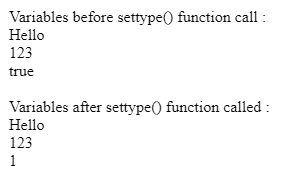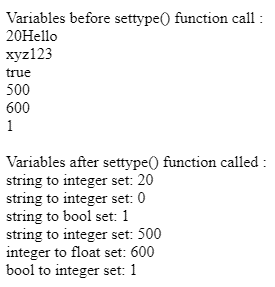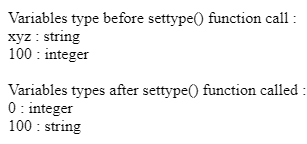Updated April 5, 2023

Introduction to PHP settype
The PHP settype() function is used to set a variable to a specific type. It is a built-in function in the PHP. The PHP settype() function set the type or modify the type of an existing variable and return true if successfully set, else return false. Sometimes we need to convert a variable from one type to an another type, so PHP provides the settype() function to perform it.
Syntax
Settype(var, type);Parameters –
- var – This is not an optional parameter that specifies the variable whose type is to be set.
- type – This is not an optional string parameter that specifies the type to set the variable to. The possible values for the type are int or integer, float or double, bool or Boolean, string, array, object, and null.
- Return value – The return value of this method is Boolean, return True if successful, else return False on failure.
Working of PHP settype() function
The PHP settype() function accepts the two-parameter as ( var, type ); both parameters are required. Suppose we have a variable of integer type as $var = 20, and we need it to convert as string, so we will call the sttype() function as settype($var, “string”), which convert the integer variable to string variable and integer value store inside as “20”.
Examples of PHP settype() function
Here are the following examples mention bellow
Example #1
Example of PHP settype() function to set the type of variable –
Next, we write the PHP code to understand the settype() function more clearly with the following example, where the settype() function is used to set the type of variable they are basically, as below –
Code:
<!DOCTYPE html>
<html>
<body>
<?php
// creating and initializing variables of string type
$var1 = "Hello";
$var2 = "123";
$var3 = "true";
// printing the values from the xml file
print("Variables before settype() function call : ");
print("<br />");
print_r($var1);
print("<br />");
print_r($var2);
print("<br />");
print_r($var3);
print("<br /><br />");
// converting the type of the variables
settype($var1, "string");
settype($var2, "integer");
settype($var3, "bool");
print("Variables after settype() function called : ");
print("<br />");
print_r($var1);
print("<br />");
print_r($var2);
print("<br />");
print_r($var3);
print("<br />");
?>
</body>
</html>An output of the above code is –
As in the above program, some of the string variables are created of string, integer and bool type in the string format, which are later set to the type basically they belong as string, integer and bool respectively by using the settype() function. In the output, we can see in the variable before set the type and after set the type.
Example #2
Example of settype() function to set the type of variable to another type –
Next, we write the PHP code to understand the settype() function, where the settype() function is used to set the type of variable they are not basically, as below –
Code:
<!DOCTYPE html>
<html>
<body>
<?php
// creating and initializing variables of string type
$var1 = "20Hello";
$var2 = "xyz123";
$var3 = "true";
$var4 = "500";
$var5 = 600;
$var6 = true;
// printing the values from the xml file
print("Variables before settype() function call : ");
print("<br />");
print_r($var1);
print("<br />");
print_r($var2);
print("<br />");
print_r($var3);
print("<br />");
print_r($var4);
print("<br />");
print_r($var5);
print("<br />");
print_r($var6);
print("<br /><br />");
// converting the type of the variables
settype($var1, "integer");
settype($var2, "integer");
settype($var3, "bool");
settype($var4, "integer");
settype($var5, "float");
settype($var6, "integer");
print("Variables after settype() function called : ");
print("<br />");
print("string to integer set: ");
print_r($var1);
print("<br />");
print("string to integer set: ");
print_r($var2);
print("<br />");
print("string to bool set: ");
print_r($var3);
print("<br />");
print("string to integer set: ");
print_r($var4);
print("<br />");
print("integer to float set: ");
print_r($var5);
print("<br />");
print("bool to integer set: ");
print_r($var6);
print("<br />");
?>
</body>
</html>An output of the above code is –
As in the above program, some of the variables are created of different types string, integer, and bool type, which are later set to the other type to which they do not belong(another type) by using the settype() function. As in the output, we can see in the variable before set the type and after set the type and difference after their types set.
Example #3
Example of settype() function to set the type of variable and verify –
Next, we write the PHP code to understand the settype() function, where the settype() function is used to set the type of variable and verify they are successfully set or not, as below –
Code:
<!DOCTYPE html>
<html>
<body>
<?php
// creating and initializing variables of string type
$var1 = "xyz";
$var2 = 100;
// printing the values from the xml file
print("Variables type before settype() function call : ");
print("<br />");
print_r($var1);
echo " : ",gettype($var1);
print("<br />");
print_r($var2);
echo " : ",gettype($var2);
print("<br /><br />");
// converting the type of the variables
settype($var1, "integer");
settype($var2, "string");
print("Variables types after settype() function called : ");
print("<br />");
print_r($var1);
echo " : ",gettype($var1);
print("<br />");
print_r($var2);
echo " : ",gettype($var2);
print("<br />");
?>
</body>
</html>An output of the above code is –
As in the above program, two variables are created of string and integer, which are later set to the another type using the settype() function, so settype() function permanently set or converts the type of variable. In the above code, the gettype() function is used to get the type of variables. As in the output, we can see in the variable types before the set and after set.
Conclusion
The PHP settype() function is a built-in function in PHP, which is used to set the type of the variables.
Recommended Articles
This is a guide to PHP settype. Here we discuss the introduction, syntax, and working of settype() function in PHP along with different examples and code implementation. You may also look at the following articles to learn more –




